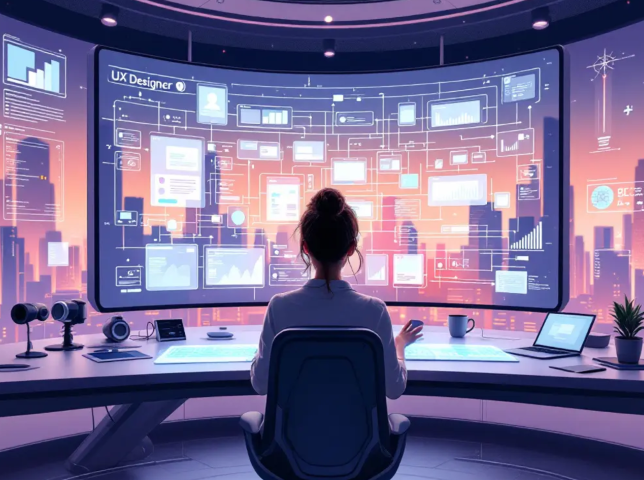Introduction
As we navigate the digital landscape of today, one thing becomes increasingly clear: Artificial Intelligence (AI) is no longer just a buzzword, but a fundamental component of our daily lives. From the apps on our phones to the websites we visit, AI is subtly enhancing user experience in ways both subtle and profound. But what does this mean for UX designers, and how can they harness the power of AI to create experiences that are truly human-centric?
In this article, we’ll explore the world of AI-powered UX design, examining the latest trends, technologies, and techniques that are shaping the future of user experience. We’ll delve into the importance of hyper-personalization, the role of continuous feedback loops in refining AI models, and the essential skills required to stay ahead of the curve.
Understanding AI Proficiency for UX Designers
Before we dive into the nitty-gritty of AI-powered UX design, it’s essential to understand the basics. So, what is AI, exactly? Simply put, AI refers to the development of computer systems that can perform tasks that typically require human intelligence, such as learning, problem-solving, and decision-making.
But AI is not a one-size-fits-all solution. Different types of AI have different applications, ranging from image recognition to natural language processing. As UX designers, it’s crucial to understand which type of AI will be most relevant to your specific project or client needs.
Key Principles to Consider When Working with AI
So, how can you apply AI in a way that enhances user experience? Here are some key principles to consider:
- User-centric approach : Always keep the user at the forefront of your design decisions.
- Transparency and explainability : Make sure users understand how AI is being used to make recommendations or decisions.
- Data quality and integrity : Ensure that data is accurate, up-to-date, and free from bias.
By keeping these principles in mind, you can harness the power of AI to create experiences that are truly human-centric.
The Role of AI in Enhancing User Experience
AI has already made a significant impact on user experience, from image recognition in Google Lens to live captions in video calls. But what does this mean for UX designers? Simply put, AI is no longer just a tool – it’s a fundamental part of the design process.
By incorporating AI into your design workflow, you can:
- Automate repetitive tasks : Save time and focus on high-level creative decisions.
- Improve user engagement : Use AI-powered tools to create personalized experiences that resonate with users.
- Enhance accessibility : Leverage AI-driven features like live captions and image recognition to improve user accessibility.
Hyper-Personalization: Transforming User Interactions
So, what is hyper-personalization? Simply put, it’s the process of tailoring your experience to each individual user based on their unique preferences, behaviors, and interests. This can be achieved through a range of techniques, including:
- Machine learning algorithms : Use machine learning algorithms to analyze user behavior and make personalized recommendations.
- Natural language processing : Leverage natural language processing to create conversational interfaces that feel more human-like.
But hyper-personalization also comes with its challenges. For example:
- Data privacy concerns : Ensure that you’re collecting and storing data in a way that’s transparent and secure.
- Bias and fairness : Be aware of potential biases in your AI-powered tools and take steps to mitigate them.
Testing and Feedback for AI Products
Continuous feedback loops are crucial when working with AI-powered products. By incorporating user feedback into the design process, you can refine AI models and create experiences that are truly tailored to user needs.
Here are some strategies for incorporating user feedback:
- A/B testing : Use A/B testing to compare different versions of your experience and see which one performs better.
- User surveys and polls : Collect feedback through regular user surveys and polls.
- Design sprints : Host design sprints with users to gather feedback and iterate on designs.
Embracing the Future of UX Design with AI
So, how can you stay ahead of the curve when it comes to AI-powered UX design? Here are some essential skills to consider:
- Data analysis and interpretation : Develop skills in data analysis and interpretation to make informed design decisions.
- Machine learning fundamentals : Understand machine learning basics, including algorithms and techniques.
- Design thinking : Practice design thinking principles to create human-centric experiences that resonate with users.
By embracing the future of UX design with AI, you can harness the power of this technology to create experiences that are truly transformative.
Conclusion
The world of AI-powered UX design is constantly evolving, but one thing remains clear: the future of user experience is all about creating experiences that are human-centric. By understanding key principles like transparency and explainability, leveraging machine learning algorithms, and incorporating continuous feedback loops into your design process, you can harness the power of AI to create experiences that truly resonate with users.
As UX designers, it’s our responsibility to stay ahead of the curve when it comes to this rapidly evolving landscape. By embracing the future of UX design with AI, we can create experiences that are not only transformative but also fundamentally human-centered.

